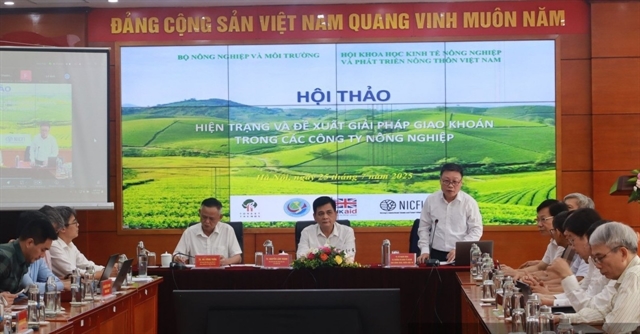 Society
Society


|
| Seminar on Current Status and Proposed Solutions for Land Contracting in Agricultural Enterprises was held in Hà Nội on July 25. Photo courtesy of Ministry of Agriculture and Environment |
HÀ NỘI – Land contracting has delivered positive impacts across Việt Nam's agricultural sector, improving the management of land and plantation resources, enhancing local livelihoods, and contributing to economic development.
As of 2024, a total of 121 agricultural enterprises had been allocated or leased 478,039ha of land nationwide.
This information was presented at the seminar titled Current Status and Proposed Solutions for Land Contracting in Agricultural Enterprises, jointly organided by the Ministry of Agriculture and Environment and the Việt Nam Association of Agricultural Economics and Rural Development Sciences in Hà Nội on July 25.
According to Nguyễn Lâm Thành, vice chairman of the National Assembly’s Ethnic Council, after 30 years of implementing land contracting policies, by 2024, agricultural companies had contracted out nearly 114,000 ha, equivalent to about 25.69 per cent of the agricultural land under company use.
Land contracting has brought positive effects such as reversing land abandonment, restoring degraded plantations from the 1990s, and mobilising social resources, especially from local residents, to participate alongside agricultural enterprises.
Thanks to State investment in capital and labour, the use of agricultural land and plantations in Việt Nam has become increasingly efficient, leading to improved local livelihoods and accelerated economic development.
According to Nguyễn Văn Tiến, Vice Chairman of the Việt Nam Association of Agricultural Economics and Rural Development Sciences, agricultural enterprises currently implement two primary forms of land contracting: agricultural land and plantation land.
“Long-term land contracting has played a pivotal role in job creation, livelihood stabilisation, and socio-economic development,” Tiến said. “It has also contributed to the advancement of new-style rural areas across the country.”
A survey across four provinces found that the average household income of contract recipients is VNĐ299 million per year, of which VNĐ192 million per year comes from company contracts, VNĐ85.17 million from other agricultural activities, and VNĐ21.8 million from non-agricultural sources.
However, contracting still faces multiple limitations, such as frequently changing legal documents, which create complications in establishing or renewing contracts. “White” contracting (no investment) or low-investment contracting still exists in many agricultural firms.
Moreover, co-ordination among Government authorities, local administrations, and companies remains weak, complicating contract management, especially in addressing violations of land use or contract terms.
The handover of land to local governments also faces many difficulties.
According to Tiến, current challenges in land contracting stem not only from objective factors but also from shortcomings in mechanisms, policies, implementation, and monitoring.
Tiến urged that the land contracting framework be strengthened and modernized, aligning with provisions under the 2024 Land Law, to better empower agricultural enterprises.
During the seminar, experts agreed that the State’s land and forest contracting policies have remained appropriate across different stages of development. These policies have addressed public needs, created employment opportunities, stabilised livelihoods, alleviated poverty, and significantly contributed to socio-economic development, particularly in forested regions.
However, the policy has seen changes over time, and many current provisions on eligible recipients, contract limits, duration, rights, and obligations are mismatched with reality, causing difficulty in establishing and fulfilling contracts.
Dr Hà Công Tuấn, former Deputy Minister of Agriculture and Rural Development, now Chairman of the Association, proposed policy adjustments to resolve bottlenecks in agricultural enterprises.
He stressed that policies must ensure post-restructuring livelihood improvements for workers and local people, leaving no one behind.
Analysing land contracting from the perspective of EU Deforestation Regulation (EUDR) compliance and Việt Nam’s agricultural export potential, Dr. Tô Xuân Phúc, director of Forest Trends, highlighted ongoing changes in company operations and land use practices to align with new national policy goals.
However, he acknowledged remaining challenges, especially regarding land use. Some stem from historical legacies; others arise from weak implementation, insufficient resources, or recent pressures driven by increased demand in export markets, prompting land expansion.
“The forestry sector is deeply integrating into global markets, opening new opportunities for agricultural and forestry products, as well as forest carbon markets. But such opportunities also bring challenges, especially regarding land use and contract management with households,” said Phúc.
“Accessing export markets and forest carbon credit markets can only become a reality if land use issues—particularly related to contracting practices—are thoroughly resolved,” he added. VNS